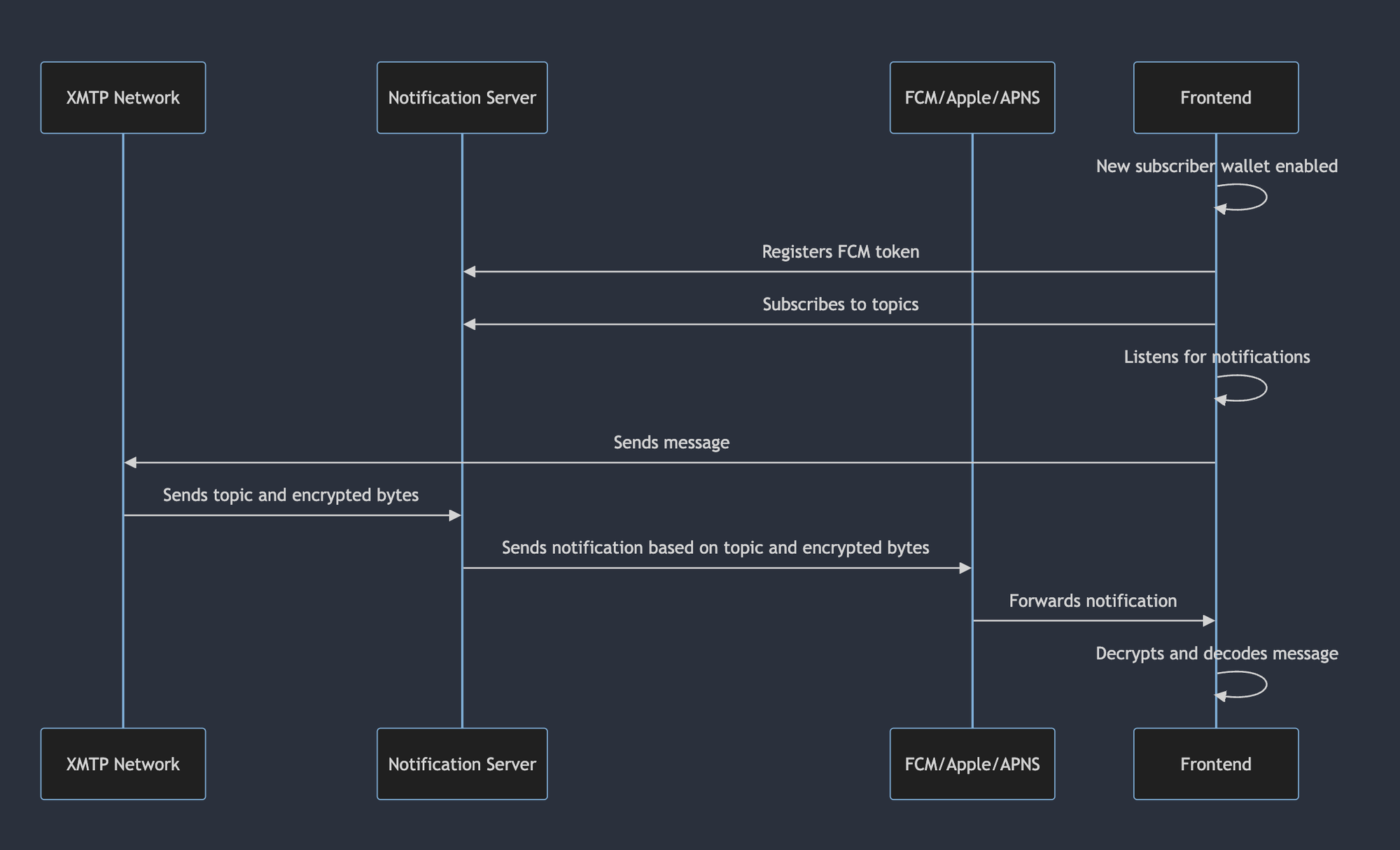Notification architecture overview
The notification architecture might appear complex initially, but we've simplified it into manageable concepts and steps. This overview walks you through the notification handling and delivery process in XMTP, using practical examples to illustrate each step.

To describe the process with an example, consider a message being sent from Alice to Bob using a mobile messaging app. This app is built with React Native for iOS devices and uses Firebase for notifications. Here is a detailed explanation of each step, along with code examples.
1. Initialize the XMTP client
Alice opens the frontend on her iOS device and initializes her new wallet with XMTP.
import { Client } from "@XMTP"; // XMTP JavaScript client
// Alice initializes her wallet on the Frontend
const XMTPClient = await Client.create(aliceSigner, { env: "dev" });
2. Register the device with Firebase
When Alice launches the frontend on her device for the first time, the app registers with Firebase to receive notifications.
// Get token from Firebase
const deviceToken = await messaging().getToken();
// Get unique ID for the device
const installationId = await installations().getId();
// Assume this function sets up your notification client
const client = createNotificationClient();
await client.registerInstallation({
installationId,
deliveryMechanism: {
deliveryMechanismType: {
value: deviceToken,
case: "FirebaseDeviceToken",
},
},
});
3. Subscribe to topics
The notification server adds Alice's installationId to certain topics. The list of subscriptionDetails includes all information needed to join topics, such as user permission and HMAC keys for safely checking messages.
consentState: Notifications are only subscribed to if theconsentStateof a conversation is "allowed". This ensures that users receive notifications only for conversations they have consented to. Learn moreInvitetopic V2: Clients use invite topics to initiate conversations between wallets. Learn moreIntrotopic V1: Clients use intro topics to store the first message sent between two wallets
let subscriptionDetails = [];
// Filter conversations to only include those with user consent, to respect privacy and avoid SPAM.
const consentedConversations = conversations.filter(
(conversation) => conversation.consentState === "allowed",
);
// Compile the subscription info, attaching the HMAC key when available.
consentedConversations.forEach((conversation) => {
subscriptionDetails.push({
topic: conversation.topic,
hmacKey: conversation.hmacKey || null,
});
});
// Special topics without HMAC keys
subscriptionDetails.push({
topic: buildUserInviteTopic(userAddress),
hmacKey: null,
});
subscriptionDetails.push({
topic: buildUserIntroTopic(userAddress),
hmacKey: null,
});
// This operation sends the subscription details to the notification service.
await notificationClient.subscribeWithMetadata({
installationId,
subscriptions: subscriptionDetails,
});
4. Listen for notifications
Alice's frontend is now listening for incoming notifications.
// Listener for incoming Firebase notifications
messaging().onMessage(async (remoteMessage) => {
console.log("A new message arrived!", remoteMessage);
});
5. Send a message
Bob sends a message to Alice using his instance of the frontend.
const bobClient = await Client.create(bobSigner, { env: "dev" });
const conversation = await bobClient.conversations.newConversation(aliceWallet);
await conversation.send("Hello Alice!");
6. XMTP network dispatch
The XMTP network sends the encrypted message and topic to the notification server.
// Pseudo-code for XMTP network sending encrypted message
const messageTopic = "XMTP/0/dm-alice-XMTP-topic-id";
sendToNotificationServer(encryptedMessage, messageTopic);
7. Trigger push notifications
The notification server triggers a push notification to Firebase.
const message = {
data: {
topic: messageTopic,
message: encryptedMessage,
},
topic: messageTopic,
};
firebase_admin.messaging().send(message);
8. Firebase notification forwarding
Firebase forwards the notification to Alice's device.
9. Decrypt the message
Alice's frontend receives the notification and decrypts the message.
// Decrypting the message when a notification is received from Firebase
Firebase.messaging().onMessage((payload) => {
const decryptedMessage = decryptMessage(payload.data.message, encryptionKey);
console.log("Decrypted message:", decryptedMessage);
});
The XMTP framework's notification architecture, in conjunction with Firebase Cloud Messaging, offers a secure and reliable approach to notification management and delivery. This comprehensive guide outlines the essential steps, from device registration to message decryption, to streamline the process and improve developers' notification implementation experience.
For more details, see A Practical Guide To Building A Push Notification Client.

